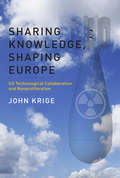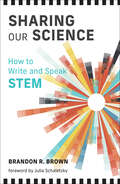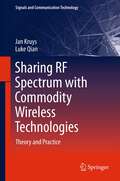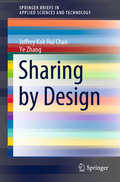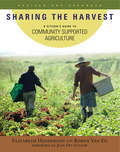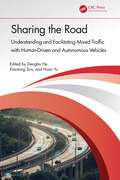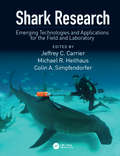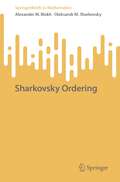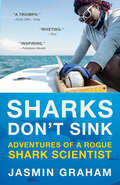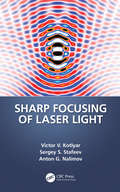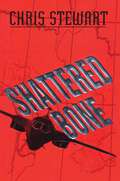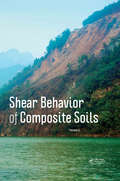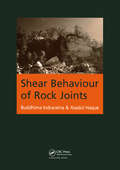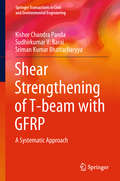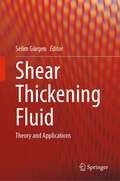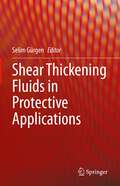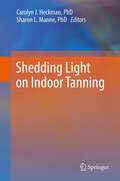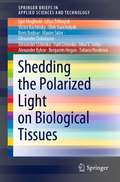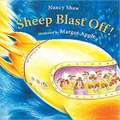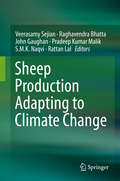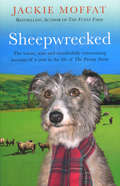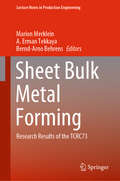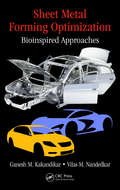- Table View
- List View
Sharing Knowledge, Shaping Europe: US Technological Collaboration and Nonproliferation (Transformations: Studies in the History of Science and Technology)
by John KrigeHow America used its technological leadership in the 1950s and the 1960s to foster European collaboration and curb nuclear proliferation, with varying degrees of success.In the 1950s and the 1960s, U.S. administrations were determined to prevent Western European countries from developing independent national nuclear weapons programs. To do so, the United States attempted to use its technological pre-eminence as a tool of “soft power” to steer Western European technological choices toward the peaceful uses of the atom and of space, encouraging options that fostered collaboration, promoted nonproliferation, and defused challenges to U.S. technological superiority. In Sharing Knowledge, Shaping Europe, John Krige describes these efforts and the varying degrees of success they achieved. Krige explains that the pursuit of scientific and technological leadership, galvanized by America's Cold War competition with the Soviet Union, was also used for techno-political collaboration with major allies. He examines a series of multinational arrangements involving shared technological platforms and aimed at curbing nuclear proliferation, and he describes the roles of the Department of State, the Atomic Energy Commission, and NASA. To their dismay, these agencies discovered that the use of technology as an instrument of soft power was seriously circumscribed, by internal divisions within successive administrations and by external opposition from European countries. It was successful, Krige argues, only when technological leadership was embedded in a web of supportive “harder” power structures.
Sharing Our Science: How to Write and Speak STEM
by Brandon R. BrownA personal, practical, and inspirational guide to written and oral STEM communications for scientists and technical professionals.In Sharing Our Science, scientist-turned-writing teacher Brandon Brown offers an eminently useful guidebook for STEM practitioners looking to communicate their technical work to either a technical or a broader audience. Professionals are increasingly required to communicate their work through blogs, podcasts, and newsletters and to submit to traditional media. After seeing his colleagues struggle to find a writing guide that tackled the unique challenges of writing and speaking about scientific topics, Brown set out to write the definitive handbook to assist STEM students, scientists, engineers, and tech workers alike.In this practical and relevant book, Brown uses his experience as a proven science communicator to cover three levels of writing: fundamental craft considerations, such as narrative tension, structure, sentences, and audience; unique scientific considerations, such as conveying numbers and utilizing metaphors; and finally, social considerations, such as public speaking and writing inside and outside of silos. In place of a reference manual, Brown&’s engaging narrative guide clarifies the fundamental principles that impact all scientific communication tasks, from white papers and slide decks to Zoom meetings and emails. Sharing Our Science represents the culmination of a lifetime of writing, research, and teaching that will enrich scientists&’ careers and illuminate the ways in which science is done and conveyed to the world.
Sharing RF Spectrum with Commodity Wireless Technologies
by Jan Kruys Luke QianMuch energy has been spent on the subject of spectrum scarcity that would threaten to stunt the growth of wireless technologies and services. This concern comes on the heels of the great successes of both cellular communications and consumer oriented communications like Wi-Fi and Bluetooth that have changed the way people use computers and communications and that have led to the creation of large new markets for products and services. The response of many spectrum regulators throughout the world in addressing these concerns has been to consider releasing more spectrum for unlicensed or for shared use. An example is the spectrum that is released by the transition to digital TV: the frequencies freed up are destined, in part, to new applications that would be license exempt. A possible beneficiary of new spectrum releases would be "the smart grid", a networked application of digital sensor and control technology to the energy delivery segment of the energy utility industry. This policy has heightened the interests of all involved in spectrum sharing and many proposals are being considered or brought forward. However, theory in this area is scarce and practice proves resistive of quick solutions. A case in point is RLAN/radar spectrum sharing in the 5GHz range: six years after the ITU-R allocated this shared spectrum, the rules for sharing as well as the means to verify compliance with these rules are not fully mature. Another recent development is the interest in spectrum pricing and trading which tend to focus on the economic aspects of spectrum sharing at the expense understanding of the limitations as well as the technical possibilities of spectrum sharing.
Sharing by Design (SpringerBriefs in Applied Sciences and Technology)
by Jeffrey Kok Chan Ye ZhangThis book answers the question of how to design a sharing system that can promote sustained, meaningful, and socially constructive sharing practices in today’s cities. To do so, it constructs a framework for practical inquiry into the design of sharing systems. Further, the book invites readers to consider questions such as: If sharing can be designed, then how does one design a sharing system for cities? Which urban conditions make this sharing system possible? What are the considerations, variables, and methods that can inform and guide the designers of a sharing system? By considering both the environmental and societal motivations for sharing, and the reality that most examples of the Sharing Economy are neither equitable in their socio-economic outcomes nor genuine in their original social promises, this book presents balanced and thoughtful answers to the questions posed above. The book will appeal to a broad readership, from students and teachers in the various design disciplines, to professionals and scholars in architecture and urbanism, business and innovation, and other related fields of the humanities and social sciences, as well as activists and policymakers committed to achieving more sustainable and equitably distributed access to urban resources.
Sharing the Harvest
by Elizabeth Henderson Robyn Van EnTo an increasing number of American families the CSA (community supported agriculture) is the answer to the globalization of our food supply. The premise is simple: create a partnership between local farmers and nearby consumers, who become members or subscribers in support of the farm. In exchange for paying in advance-at the beginning of the growing season, when the farm needs financing-CSA members receive the freshest, healthiest produce throughout the season and keep money, jobs, and farms in their own community. In this thoroughly revised and expanded edition of a Chelsea Green classic, authors Henderson and Van En provide new insight into making CSA not only a viable economic model, but the right choice for food lovers and farmers alike. Thinking and buying local is quickly moving from a novel idea to a mainstream activity. The groundbreaking first edition helped spark a movement and, with this revised edition, "Sharing the Harvest" is poised to lead the way toward a revitalized agriculture.
Sharing the Road: Understanding and Facilitating Mixed Traffic with Human-Driven and Autonomous Vehicles
by Huan Yu Dengbo He Xiaotong SunWith the advancements in sensor and computation technologies, connected autonomous vehicle (CAV) services are being tested and deployed on public roads, sharing the road with human- driven vehicles (HVs). This brings challenges to traffic safety, due to uncertainty in HVs behaviors. To address these challenges, Sharing the Road offers solutions to create a safer world where HVs and AVs mix freely on our roads.Presented from a team of researchers from different domains offering varying perspectives, this book systematically summarizes the issues and trends of mixed traffic, from the micro (such as vehicle algorithm design) to the macro (including traffic flow optimization and policy) perspectives. Customized car- following models describing the behaviors of HVs when interacting with CAVs and control algorithms optimizing the traffic flow in terms of traffic safety and efficiency are discussed. The title also summarizes approaches to model HVs’ behaviors and case studies of real-life examples are provided, leaving the reader with a detailed vision of the future of a mixed- traffic world.This title will appeal to professionals at any career stage in the fields of human factor engineering, traffic engineering, urban design, and vehicle engineering.
Shark Research: Emerging Technologies and Applications for the Field and Laboratory (CRC Marine Biology Series)
by Jeffrey C. Carrier, Michael R. Heithaus and Colin A. SimpfendorferOver the last decade, the study of shark biology has benefited from the development, refinement, and rapid expansion of novel techniques and advances in technology. These have given new insight into the fields of shark genetics, feeding, foraging, bioenergetics, imaging, age and growth, movement, migration, habitat preference, and habitat use. This pioneering book, written by experts in shark biology, examines technologies such as autonomous vehicle tracking, underwater video approaches, molecular genetics techniques, and accelerometry, among many others. Each detailed chapter offers new insights and promises for future studies of elasmobranch biology, provides an overview of appropriate uses of each technique, and can be readily extended to other aquatic fish and marine mammals and reptiles. Including chapter authors who were pioneers in developing some of the technologies discussed in the book, this book serves as the first single-source reference with in-depth coverage of techniques appropriate for the laboratory and field study of sharks, skates, and rays. It concludes with a unique section on Citizen Science and its application to studies of shark biology. This is a must-read for any marine biologist or scientist working in the field of shark biology, as well as marine biology students and graduates.
Sharkovsky Ordering (SpringerBriefs in Mathematics)
by Alexander M. Blokh Oleksandr M. SharkovskyThis book provides a comprehensive survey of the Sharkovsky ordering, its different aspects and its role in dynamical systems theory and applications. It addresses the coexistence of cycles for continuous interval maps and one-dimensional spaces, combinatorial dynamics on the interval and multidimensional dynamical systems. Also featured is a short chapter of personal remarks by O.M. Sharkovsky on the history of the Sharkovsky ordering, the discovery of which almost 60 years ago led to the inception of combinatorial dynamics. Now one of cornerstones of dynamics, bifurcation theory and chaos theory, the Sharkovsky ordering is an important tool for the investigation of dynamical processes in nature. Assuming only a basic mathematical background, the book will appeal to students, researchers and anyone who is interested in the subject.
Sharks Don't Sink: Adventures of a Rogue Shark Scientist
by Jasmin GrahamThe uplifting story of a young Black scientist&’s challenging journey to flourish outside the traditional confines of academia, inspired by her innate connection to nature&’s most misunderstood animal—the shark."Jasmin Graham has that winning combination of talent and grit needed to excel as a scientist. Every girl who wants to be a marine biologist should have this book." —Hope Jahren, New York Times bestselling author of Lab Girl and The Story of MoreSharks have been on this planet for over 400 million years, so there is a lot they can teach us about survival and adaptability. For example: how do sharks, which unlike other fish are denser than water, stay afloat? They keep moving. When Jasmin Graham, an award-winning young shark scientist, started to feel that the traditional path to becoming a marine biologist was pulling her under, she remembered this important lesson: keep moving forward.If navigating the choppy waters of traditional academic study was no longer worth it, then that meant creating an ocean of her own. Jasmin joined with three other Black women to form Minorities in Shark Sciences (MISS), an organization dedicated to providing support and opportunities for other young women of color. She became an independent researcher: a rogue shark scientist, seeking ways to keep these extraordinary endangered creatures swimming free—just like her.Sharks Don&’t Sink is a riveting, moving, and ultimately triumphant memoir at the intersection of science and social justice: a guidebook to how we can all learn to respect and protect some of nature&’s most misunderstood and vulnerable creatures—and grant the same grace to ourselves.
Sharp Focusing of Laser Light
by Victor V. Kotlyar Sergey S. Stafeev Anton NalimovReaders will learn in which ways light can be "confined" within a subwavelength region smaller than half a wavelength. Strictly within the focal spot, all degrees of freedom of light interact and manifest themselves in a dramatic way. The size and shape of the focal spot and the magnitude of side-lobes depend on the polarization state alongside phase and amplitude distributions of a light beam. Readers will learn techniques in which inhomogeneously (i.e., azimuthally and radially) polarized optical beams can be focused. In sharp focus, exotic phenomena can occur, including the negative propagation of light and a toroidal optical flow. Throughout the book, the numerical simulation is performed using the rigorous solution of Maxwell’s equations based on a Finite-Difference Time-Domain (FDTD) approach, which makes the results of modeling highly reliable. The photonic components, including optical metasurfaces, discussed in the book have been implemented using state-of-the-art techniques of electron beam writing and reactive ion-beam etching of microrelief. Two chapters are concerned with photonics hot spots, which deal with the control of light by means of optical metasurfaces and the generation of an energy backflow in the region of sharp focus of a laser beam. Another hot topic is diffractive polarization converters implemented as subwavelength diffraction gratings to convert polarization of light. By way of illustration, such converters are shown to perform linear-to-radial or linear-to-azimuthal polarization conversion. The book describes advanced photonic components fabricated by the authors to perform sharp focusing of light, including binary zone plates, binary axicons, a planar photonic crystal lens, diffraction polarization converters, and metalenses. This book is a must-have for individuals and institutions studying cutting edge optics.
Shattered
by Teri TerryThe riveting finale of the Slated trilogy-- a thought-provoking psychological thriller set in a disturbingly plausible future where the government and its enemies compete to control the minds of the young Kyla is in danger from both the government Lorders who erased her memory and the terrorists who tried to use her. So now she's on the run. Sporting a new identity and desperate to fill in the blank spaces of her life pre-Slating, Kyla heads to a remote mountain town to try to reunite with the birth mother she was kidnapped from as a child. There she is hoping all the pieces of her life will come together and she can finally take charge of her own future. But even in the idyllic wilderness and the heart of her original family, Kyla realizes there is no escape from the oppressive Lorders. Someone close to her may be one of them, and even more frighteningly, her birth mother has been keeping secrets of her own. In this stunning series finale, Kyla finally finds out who she really is--and the road to this discovery, and to deciding who she wants to become, is full of dangerous twists and turns that will keep readers riveted. Praise for the Slated trilogy: "Even if you're sick of teenage dystopias, this paranoid mind-wiping novel will thrill you."--io9 "A refreshing change from the often overly naïve heroines of recent YA science fiction. . . . Stands out from the dystopian pack. . . . Readers will anxiously await sequels to come."--The Bulletin of the Center for Children's Books "Terry's world is remarkably like today's. . . . The romance and politics keep suspense ratcheted up. . . . Intriguing--readers will be on tenterhooks for the next one."--Kirkus Reviews "A suspenseful page-turner with a highly sympathetic and strong female protagonist. A perverse sense of claustrophobic dread grows throughout the novel. . . . Will have readers waiting eagerly for a sequel."--Booklist
Shattered Bone
by Chris StewartShattered Bone: The theft, hijacking, or unauthorized flight of a B-1B bomber loaded with nuclear weapons. Such activity is to be considered a class &“A&” security violation. The incident aircraft will be destroyed using any and all means available. Its destruction is the highest priority. –Air Force code manual 13-12A nightmare scenario becomes terrifying reality when the Ukraine calls in an undercover agent from the old Russian regime who has lived in America nearly all his life and is now an elite bomber pilot. Drawn back to his home, the agent is pitted against a Russia ambitious to rebuild its tyrannical power. As his stolen bomber sweeps down on its target, the world braces for nuclear war, and everyone is left to wonder: Who is the renegade pilot working for?Shattered Bone crackles with an authenticity and life experience rarely encountered in techno-thrillers.
Shear Behavior of Composite Soils
by Yanrong LiThis book has the purpose of developing an understanding of the factors determining and influencing the shear behavior of soils, with emphasis on composite soils, as they are the most encountered materials in geological and geotechnical engineering in mountainous areas. This objective is reached by examining the soil compressibility, structure of shear zone and its evolution, and water content of shear zone and shear mode of soils together with analyses of the influences of intrinsic properties, e.g. Atterberg limits, particle size distribution, particle shape, and testing conditions, e.g. normal stress and shearing rate. An in-depth review is presented in an approximately chronological order and covers almost all the factors that are believed to influence the mechanical behavior of soils. The equipment and test techniques for shear strength of soils are detailed. The residual shear behavior of composite soil is investigated by means of a systematic laboratory testing program using a large ring shear apparatus and an intermediate direct shear box. The Fast Fourier Transform is employed for the first time to analyze the fluctuations of measured shearstress and discovers the close relationships with both intrinsic properties of soils and testing conditions. Although the book is aimed primarily at researchers in geological and geotechnical engineering, it contains material of interest to students of geology and soil science and also should be a useful reference for practicing engineers faced with composite soils.
Shear Behaviour of Rock Joints
by Asadul Haque Buddhima IndrarataThis title covers the fundamental properties of rock joints, the method of laboratory testing of rock joints, and shear strength assessment under different loading conditions. This work is intended as a reference text for students and practitioners in mining and rock engineering.
Shear Strengthening of T-beam with GFRP: A Systematic Approach (Springer Transactions in Civil and Environmental Engineering)
by Kishor Chandra Panda Sudhirkumar V. Barai Sriman Kumar BhattacharyyaThis book presents a systematic approach to the experimental, theoretical, and numerical investigation of reinforced concrete (RC) T-beams strengthened in shear with glass-fibre-reinforced polymers (GFRP) with variation in transverse steel reinforcements. It discusses experiments conducted on simply supported RC T-beams for control beams with and without transverse steel reinforcements and beams strengthened in shear with GFRP sheets and strips in different configurations, orientations, and variation of layers for each type of stirrup spacing. The book also includes a detailed numerical study using ANSYS performed in two stages. The first stage consists of selecting and testing relevant materials in the laboratory to establish the physical and mechanical properties of the materials. The second stage then involves testing beams for shear under two-point static loading systems. The test results demonstrate the advantage of using an externally applied, epoxy-bonded GFRP sheets and strips to increase the shear capacity of the beams. The finite element method (FEM) analysis results verify the experimental results. The book will serve as a valuable resource for researchers and practicing civil engineers alike.
Shear Thickening Fluid: Case Studies in Engineering
by Selim GürgenShear Thickening Fluid: Case Studies in Engineering provides a set of case studies and research data on the cutting-edge technology of shear thickening fluid (STF) to assist readers with understanding the adaptive behavior of STF in different engineering applications. Various engineering designs are adapted by including STF to take advantage of this smart material in the areas of protective structures, energy-absorbing systems, vibration-damping devices, and surface finishing operations. A companion volume to the book Shear Thickening Fluid: Theory and Applications, this volume will be a valuable reference for practicing engineers, researchers, and scientists working in advanced materials, smart structures, and intelligent engineering applications.
Shear Thickening Fluid: Theory and Applications
by Selim GürgenShear Thickening Fluid: Theory and Applications provides a complete reference on shear thickening fluid (STF) and STF applications for engineers, researchers, and scientists. STF rheology is discussed in terms of several factors, including suspension medium, particle size, particle shape, and environmental conditions. Single-phase STF is discussed, and the novel concept of multi-phase STF is examined by considering various fillers in this smart fluid. Prominent applications of STF are categorized as multi-functional systems, adaptive damping devices, surface finishing operations, and protective structures, and the applications are described by discussing the smart behavior of STF.
Shear Thickening Fluids in Protective Applications
by Selim GürgenThis book is a complete reference to the use of shear thickening fluid (STF) in protective applications. It discusses the adaptive behavior of STF in various systems and how it is used effectively in a wide range of protective applications from low-velocity to high-velocity conditions. Covered applications include STF-based energy absorbing systems, anti-impact structures, deceleration devices, shock attenuation composites, and body armor applications. Shear Thickening Fluid in Protective Applications will be a valuable reference for practicing engineers, researchers, and scientists working in advanced materials, protective applications, and smart structures.
Shedding Light on Indoor Tanning
by Carolyn J. Heckman Sharon L. ManneSince the industrialization and urbanization of the Western workforce, tanned skin has been perceived increasingly as attractive and fashionable for naturally light-skinned individuals. However, in addition to causing tanning, photo-aging, and other health effects, ultraviolet radiation (UV) is a well-known carcinogen. Despite wide-spread awareness of UV risks, tanning has become increasingly popular in several Western countries including the USA. While millions of individuals tan indoors each day, relatively little is known about this phenomenon. This book fills that gap by providing an overview of indoor tanning, reasons for its popularity, its risks including skin cancers, and the public health context surrounding the behavior. We have invited some of the preeminent experts in the field to summarize the existing scientific literature for each of the chapters. Shedding Light on Indoor Tanning is an up-to-date and comprehensive book that provides a unique and essential overview of the most significant current issues related to indoor tanning for scientists, educators, students, clinicians, and the general public interested in dermatology, aesthetic trends, skin care, and skin cancer.
Shedding the Polarized Light on Biological Tissues (SpringerBriefs in Applied Sciences and Technology)
by Igor Meglinski Liliya Trifonyuk Victor Bachinsky Oleh Vanchulyak Boris Bodnar Maxim Sidor Olexander Dubolazov Alexander Ushenko Yurii Ushenko Irina V. Soltys Alexander Bykov Benjamin Hogan Tatiana NovikovaThis book explores the early-stage detection of cancer using polarized light. It discusses the diverse properties of the light (temporal and spatial coherence, polarization, fluorescence, etc.) that can be used non-invasively as an optical technique for recognizing precancerous lesions, which could become a reliable and accurate method for cancer screening. The search for the effective means for cancer screening is of particular interest to scientific and medical communities, because cancer takes its toll around the globe with no respect for age or gender. Early detection of the disease is a key factor in increasing the survival rate and patients’ quality of life.
Sheep Blast Off! (Fountas & Pinnell LLI Blue #Level H)
by Nancy ShawWhen a mysterious spacecraft lands in a nearby pasture, the lovable, blundering sheep get in gear for the ride of their lives! Unfortunately, these sheep don’t know the first thing about piloting a spaceship . . . but there may be someone else on board who does! Readers will have a blast with Nancy Shaw’s clever rhymes and Margot Apple’s hilarious illustrations in this Sheep adventure.
Sheep Production Adapting to Climate Change
by Raghavendra Bhatta Rattan Lal Veerasamy Sejian John Gaughan Pradeep Kumar Malik S. M. K. NaqviThis book presents a compilation of the latest findings from reputed researchers around the globe, covering in detail climate change and its effects on sheep production. In the current global climate change scenario, information related to its impact on livestock agriculture is lacking. The negative impacts of climate change are already being felt by all livestock species. Further, the mitigation and amelioration strategies that are applicable for one species may not hold true for another. As such, concerted research efforts are needed to identify species-specific strategies for mitigation and adaptation. With that goal in mind, this book is the first of its kind to gather comprehensive information pertaining to the impact of climate change on various aspects of sheep production. It also sheds light on the role of sheep with regard to the global greenhouse gas pool. The book highlights the status quo of sheep production from climate change perspectives and projects the significance of adapting future sheep production to the challenges posed by climate change. It addresses in detail the various adaptations, methane mitigation and amelioration strategies needed to sustain sheep production in the future. In addition, the book presents development plans and policies that will allow the sheep industry to cope with current climate changes and strategies that will lessen future impacts. Bringing together essential information prepared by world-class researchers hailing from different agro-ecological zones, this book offers a unique resource for all researchers, teachers and students associated with sustaining the sheep production in the face of global change.
Sheepwrecked
by Jackie EllisThis journey through the changing seasons at Rowfoot Farm - tupping time in the autumn, winters as wet, bleak and cold here in Cumbria as elsewhere, lambing and the glories of spring, a bucolic, bee-filled Eden Valley summer with its many shows and fairs - will reveal much that you need to know about the countryside, its quirky customs and ways, and most likely a great deal that you don't. They no longer burn witches (not because they're lily-livered, it's just that getting the necessary timber from sustainable forests is a real chore). You'll find nothing here about welly-wanging either. Jackie doesn't wang her wellies, she just gets them muddy. You won't need to, of course, as this book will ensure you experience rural life vicariously and very cleanly.Along the way, Jackie bumps into friends old and new, peeps back over her shoulder every now and then to recall times past, oh and it wouldn't be her if she didn't have the occasional impassioned rant or take the odd pop at the establishment, but rest assured she's quite gentle with them. So join Jackie (and Katie the Lurcher, Blossom the Cob and Rowfoot's many other residents, four- and two-legged) as she recounts the occasional pitfall and many pleasures of running a small farm in one of the most beautiful parts of England.
Sheet Bulk Metal Forming: Research Results of the TCRC73 (Lecture Notes in Production Engineering)
by A. Erman Tekkaya Bernd-Arno Behrens Marion MerkleinThis book presents the findings of research projects from the Transregional Collaborative Research Centre 73. These proceedings are the result of years of research into sheet–bulk metal forming. The book discusses the challenges posed by simulating sheet–bulk metal forming. It takes into account the different phenomena characteristic to both sheet and bulk forming fields, and explores the demands this makes on modelling the processes. It then summarizes the research, and presents from a practitioner's point of view. This means the book is of interest to and helps both academics and industrial engineers within the field of sheet–bulk metal forming.
Sheet Metal Forming Optimization: Bioinspired Approaches
by Ganesh M. Kakandikar Vilas M. NandedkarAutomotive and aerospace components, utensils, and many other products are manufactured by a forming/drawing process on press machines of very thin sheet metal, 0.8 to 1.2 mm. It is imperative to study the effect of all involved parameters on output of this type of manufacturing process. This book offers the readers with application and suitability of various evolutionary, swarm, and bio-inspired optimization algorithms for sheet metal forming processes. Book initiates by presenting basics of metal forming, formability followed by discussion of process parameters in detail, prominent modes of failure, basics of optimization and various bioinspired approaches followed by optimization studies on various industrial components applying bioinspired optimization algorithms. Key Features: • Focus on description of basic investigation of metal forming, as well as evolutionary optimization • Presentation of innovative optimization methodologies to close the gap between those formulations and industrial problems, aimed at industrial professionals • Includes mathematical modeling of drawing/forming process • Discusses key performance parameters, such as Thinning, Fracture, and Wrinkling • Includes both numerical and experimental analysis
